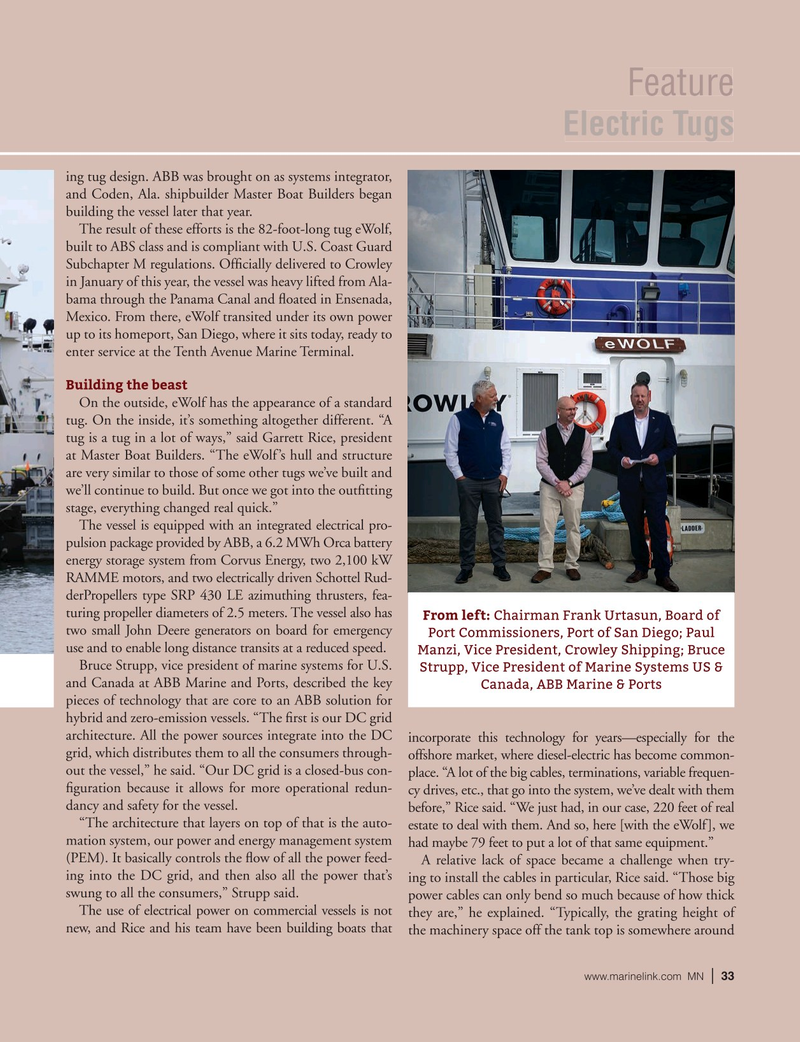
Page 33: of Marine News Magazine (April 2024)
Read this page in Pdf, Flash or Html5 edition of April 2024 Marine News Magazine
Feature
Electric Tugs ing tug design. ABB was brought on as systems integrator, and Coden, Ala. shipbuilder Master Boat Builders began building the vessel later that year.
The result of these efforts is the 82-foot-long tug eWolf, built to ABS class and is compliant with U.S. Coast Guard
Subchapter M regulations. Of? cially delivered to Crowley in January of this year, the vessel was heavy lifted from Ala- bama through the Panama Canal and ? oated in Ensenada,
Mexico. From there, eWolf transited under its own power up to its homeport, San Diego, where it sits today, ready to enter service at the Tenth Avenue Marine Terminal.
Building the beast
On the outside, eWolf has the appearance of a standard tug. On the inside, it’s something altogether different. “A tug is a tug in a lot of ways,” said Garrett Rice, president at Master Boat Builders. “The eWolf’s hull and structure are very similar to those of some other tugs we’ve built and we’ll continue to build. But once we got into the out? tting stage, everything changed real quick.”
The vessel is equipped with an integrated electrical pro- pulsion package provided by ABB, a 6.2 MWh Orca battery energy storage system from Corvus Energy, two 2,100 kW
RAMME motors, and two electrically driven Schottel Rud- derPropellers type SRP 430 LE azimuthing thrusters, fea- turing propeller diameters of 2.5 meters. The vessel also has
From left: Chairman Frank Urtasun, Board of two small John Deere generators on board for emergency
Port Commissioners, Port of San Diego; Paul use and to enable long distance transits at a reduced speed.
Manzi, Vice President, Crowley Shipping; Bruce
Bruce Strupp, vice president of marine systems for U.S.
Strupp, Vice President of Marine Systems US & and Canada at ABB Marine and Ports, described the key
Canada, ABB Marine & Ports pieces of technology that are core to an ABB solution for hybrid and zero-emission vessels. “The ? rst is our DC grid architecture. All the power sources integrate into the DC incorporate this technology for years—especially for the grid, which distributes them to all the consumers through- offshore market, where diesel-electric has become common- out the vessel,” he said. “Our DC grid is a closed-bus con- place. “A lot of the big cables, terminations, variable frequen- ? guration because it allows for more operational redun- cy drives, etc., that go into the system, we’ve dealt with them dancy and safety for the vessel.
before,” Rice said. “We just had, in our case, 220 feet of real “The architecture that layers on top of that is the auto- estate to deal with them. And so, here [with the eWolf], we mation system, our power and energy management system had maybe 79 feet to put a lot of that same equipment.” (PEM). It basically controls the ? ow of all the power feed-
A relative lack of space became a challenge when try- ing into the DC grid, and then also all the power that’s ing to install the cables in particular, Rice said. “Those big swung to all the consumers,” Strupp said.
power cables can only bend so much because of how thick
The use of electrical power on commercial vessels is not they are,” he explained. “Typically, the grating height of new, and Rice and his team have been building boats that the machinery space off the tank top is somewhere around www.marinelink.com MN 33|

 32
32

 34
34
